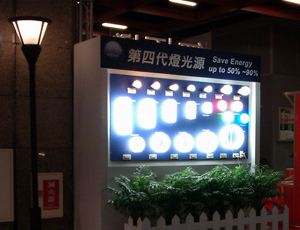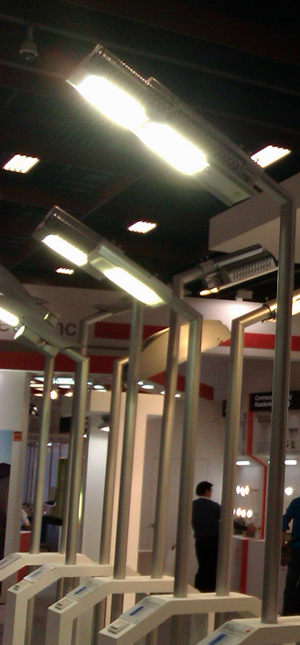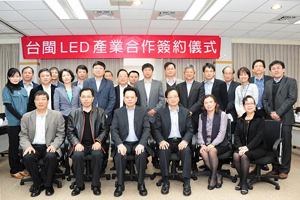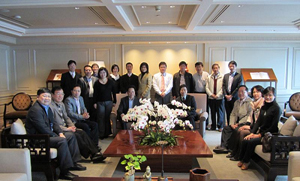LED Lighting Alliance Set Up to Speed Industry Consolidation
More vertical integration needed to beat growing competition
2013/01/07 | By Michelle HsuThe Taiwan LED Street Light Industry Alliance, which was organized by the Industrial Technology Research Institute (ITRI) in August 2010, has decided to upgrade itself to an industry association and rename itself the “Taiwan LED Light Industry Alliance” so that it will be able to take in all LED-related companies as members. This move, it is said, will help reinforce the collective strength of the industry and boost its global competitiveness.
The original Taiwan LED Street Light Industry Alliance was formed at a time when the LED lighting market was just emerging and government leadership was needed to encourage the use of this new kind of energy-saving lighting as a replacement for conventional lights. Street lamps were pinpointed as the first target for government-subsidized LED lights. ITRI stressed the need for a collective body to formulate criteria for product standards and quality for street lamps, especially in regard to safety.
LED lighting manufacturers have proliferated since then and have launched a wide variety of LED products in addition to street lamps. The alliance recently decided that, in view of the optimistic prospects for the market, it was time to expand its membership to all sectors of the LED lighting industry, including LED packaging, lighting modules, control systems, and optical devices, among others. Almost all of Taiwan's qualified companies have joined.

The organization now aims to boost the industry's vertical integration and develop product standards for all LED-related producers. “Vertical integration is urgently needed for Taiwan's LED lighting companies, considering that the fast-growing LED industries in China and South Korea have surpassed Taiwan in annual LED production,” explained Tung Chien-hsiang, chairman and director of ITRI's Green Energy & Environment Research Laboratories.
The need for consolidation is further illustrated by the fact that global leaders in the LED lighting industry—Philips, GE, Osram—all benefit from the support of partners both upstream and downstream.
Alliance Structure
The newly upgraded alliance retains its original structure, with a membership that includes research institutions and other related organizations in addition to companies. It has three committees, each with a convener and deputy convener, charged with technology development, product standards, and industrial development, respectively.
The mission of the technology development committee is to promote cooperation and interaction among upstream, midstream, and downstream member companies so as to help them integrate resources and technologies.

The product standards committee keeps a close eye on the development of international LED standards and formulates product standards for the reference of the government. It also aims to help with the establishment of an LED lighting test platform, the formulation of LED lighting safety requirements, and the coordination of safety regulations in the greater China area.
The purpose of the industrial development committee is to gather information on LED lighting development and build up a database for the sharing of information with members and other interested parties.
Cross-strait Cooperation
One of the main tasks of the alliance is to promote interaction and cooperation between Taiwan and China, and ever since the establishment of its predecessor two years ago it has been holding activities together with partners on the other side of the strait. It organized a delegation to visit the Fujian Provincial High-tech Promotion Association in October last year, for example, after which Liu Jieming, chairman of the Fujian Electronics & Information (Group) Co. came to Taiwan to visit the alliance and its key member companies.
During his visit, Liu signed an agreement for technological cooperation with the alliance, initially targeting LED lighting for civil engineering projects. The alliance anticipates considerable business opportunities as a result of the agreement, since Fujian will need large amounts of LED lighting for tunnels to be built during the coming five years. The tunnels will need an estimated total of more than three million LED lamps, with a value of almost NT$100 million.
Product Standards
A meeting on street lamp safety, held by the alliance together with related organizations in Fujian Province, reached a rough consensus on high-factoring LED street lamps and led to the signing of a mutual recognition agreement for LED street lamp standards with the Fujian Optical Technology Association. This is a critical move for Taiwanese LED lamp makers that want to develop sales in China.
Sales Promotion
“Taiwan's LED lighting companies have an advantage in terms of manufacturing technology,” cautioned Chien Feng-jen, chairman of alliance member Formosa Epitaxy Inc., “but they lack the marketing skills they need to promote sales in the international market.” To help make up for this deficiency, said alliance chairman Tung, the alliance will use its collective power to seek international business opportunities.

In addition to China, the alliance is eyeing the U.S. and Europe, the two biggest LED markets in the world. It has already made contacts with Polish buyers this year, and expects concrete results in the near future. But China is still where it has achieved the most, so far. In addition to the mutual recognition agreement on LED street lamp standards, it has also signed an agreement with the Fujian Optical Technology Association for cooperation in the development of LED lighting application models. This latter agreement calls for the formation of a joint venture to promote LED lamp applications.




